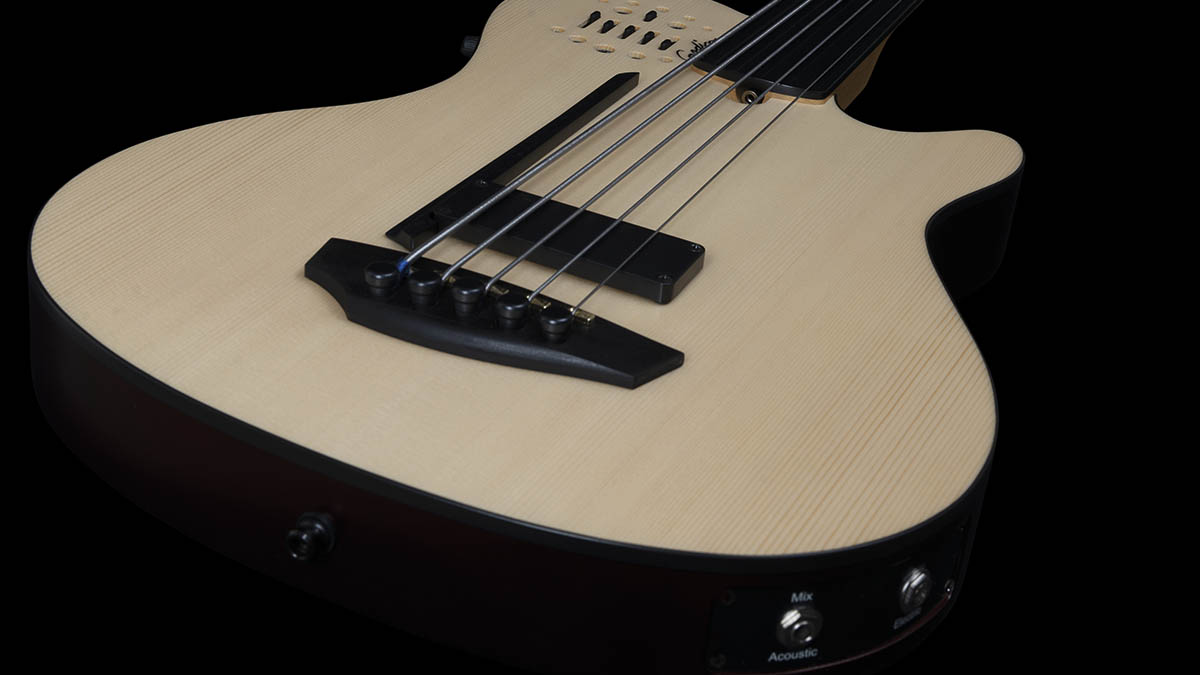Guitar World Verdict
Consider the A5 a high-end asset if your music needs a reasonable approximation of an acoustic sound, or if you spend a lot of time recording.
Pros
- +
Effortlessly playable.
- +
Plenty of onboard EQ options.
- +
High-quality build.
Cons
- -
Heavy.
- -
Expensive.
- -
Unlabeled controls.
You can trust Guitar World
Godin’s sumptuous A4 and A5 acoustic-electric basses, the AE range, have been around for a few years: this new 2021 version has a redesigned electronics suite for bass players looking for an acoustic element to their sound.
Beautifully designed and assembled, the A5 that we’ve been sent for review comes with a price tag that will make most of us wince, especially in these impoverished early months of the year– but you do get a whole lot of bass innovation for your bucks.
Build Quality

This instrument oozes a feeling of quality, from the semi-gloss finish of the body, the almost frictionless rear neck finish and the diamond-hard Richlite fretboard. It feels expensive but also innovative, partly because its construction – essentially a chunky, Precision-style neck bolted to a partly acoustic body – is genuinely unusual.
We’re told that there are two chambers in the body, but you’d never know that without unscrewing the preamp cover in the rear top bout. The lightish weight of the body does make it feel slightly insubstantial, and there’s some neck dive due to the unapologetically large dimensions of the headstock and its tuners: a smaller headstock would have made more sense for this reason.
Still, you can counter this slight imbalance with ease with judicious use of the top-mounted thumb rest, which all bass guitars will have after the revolution.

The A5 is a reasonably heavy bass, coming in at 9.3 pounds, partly because there’s a lot of electronics under the hood, and also because of the neck profile, which is hefty without actually approaching baseball-bat dimensions.
Note that there are two output jacks, in a kind of Schrödinger’s Signal situation that it took me a minute to figure out. Use the one marked Acoustic and leave the one labelled Electric alone, and you get a mix of the two pickup systems mentioned below; use them both, and they send the separate acoustic and electric signals that you’d expect.
All the latest guitar news, interviews, lessons, reviews, deals and more, direct to your inbox!

Sounds and Playability
The ace in this bass’s pack, so to speak, is its two pickup systems. One is a standard magnetic pickup, in this case a Lace Sensor unit fitted close to the bridge – presumably it’s located back there to compensate as much as possible for the low end and low mids favored by the instrument.
Controlled with rotary volume and tone knobs on the top bout of the bass, the pickup produces a familiar range of electric tones, from the thunderous to the treble-heavy.
The second, more elaborate system is based on LR Baggs saddle transducers in the bridge. While the press release claims that this gets you “an authentic acoustic double bass sound”, I think that’s a touch optimistic.

What you do get, especially if you spend some time working with the three-band EQ, is a thoroughly decent quasi-acoustic tone, with a hollow thud and rasp that upright players will recognize. You can tweak the sound still further with a ‘saturation’ slider, which Godin have told BP has been designed specifically with acoustic sounds in mind, and a ‘Fat switch’, which adds a touch of boost in the low mids.
It’s a clever system, although you may find yourself a bit frustrated by the fact that none of the eight controls on the bass are labeled. Of course, the bass looks cooler without a load of text scribbled all over it, but that will be less of a priority when it’s pitch-dark on stage and you inadvertently boost the volume instead of the EQ. Yes, it happens.
The playability of this bass is off the chart, assuming there is such a chart. The super-low action of our review model complements the hard fingerboard, and the effort required to play a mwah-heavy line is minimal.
Thumping and plucking is doable, with the obvious caveats that flatwound strings and no frets don’t exactly enable this technique. The exceptionally clear, present tones in the upper register make the A5 a soloist’s dream, although you might want to deploy an external preamp if a glassy top end is what you need.
Conclusion
We spend a lot of time here at BP playing and writing about affordable basses that you can take on tour because it doesn’t really matter if they break. This bass is the opposite of those.
Big in body and tone, costly, and made of very fine materials that you really don’t want to damage, it’s resolutely luxurious, and delivers a very fine return for your investment.
Specs
- PRICE: $2,300 MSRP
- MADE IN: Canada
- BODY: Two-chambered Canadian Laurentian basswood with solid spruce top
- NECK: Hard Rock Maple, 34” scale
- NECK JOIN: Bolt-on, four bolts
- FINGERBOARD: Richlite, Graphtech nut
- PICKUPS: Lace Sensor magnetic pickup plus LR Baggs saddle transducers
- ELECTRONICS: Custom-voiced LR Baggs preamp, electric and acoustic outputs
- CONTROLS: Volume and tone for pickup; ‘Fat switch’ plus volume, bass, mid, treble and saturation sliders for saddle transducers
- HARDWARE: Chrome tuners, ebony bridge
- WEIGHT: 9.3lbs
- LEFT-HANDED OPTION AVAILABLE: No
- CASE/GIGBAG: Gigbag
- CONTACT: Godin
Joel McIver was the Editor of Bass Player magazine from 2018 to 2022, having spent six years before that editing Bass Guitar magazine. A journalist with 25 years' experience in the music field, he's also the author of 35 books, a couple of bestsellers among them. He regularly appears on podcasts, radio and TV.



